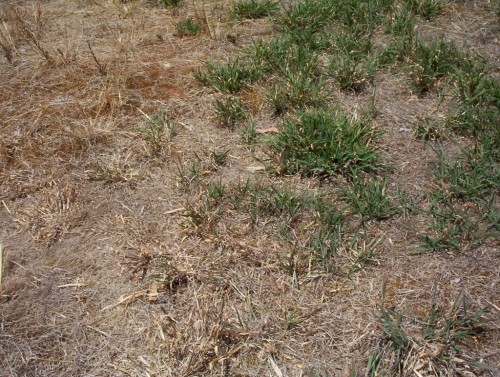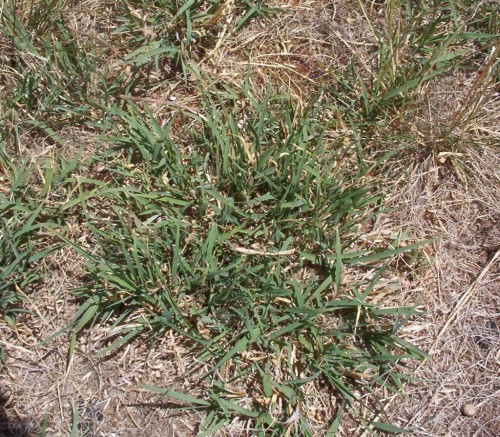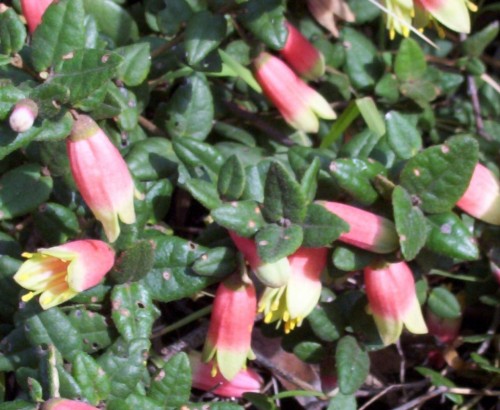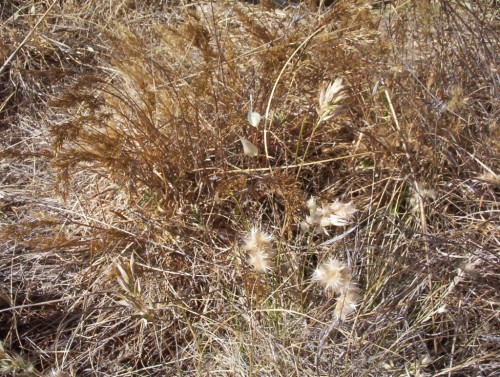Chloris truncata (Windmill Grass)
This grass is one that is on a list of reccommended lawn substitutes, along with Austrodanthonia (Wallaby Grass), and Microlaena stipoides (Weeping Rice Grass). I was warned off the Microlaena because it really is a higher rainfall species, 500 – 700mm rain. As we are in a rain shadow, and a winter wet dry summer area (344mm rain per year), it was going to be a struggle to keep this looking reasonable without using more water than I wanted to. After all it is supposed to substitute for water hungry grasses.
The good thing that happened is that the Windmill Grass is green and has been for two and a half weeks. That is in spite of at least four days with temperatures above 41C and at least seven days around 36C. I will be letting it go and observing how long it takes to be unacceptable as a lawn. I don’t see much point in having a lawn if it can’t be kept green.I was very pleased with the appearance of the plant. I had dismissed this species because my experience had shown it to be too tufted and therefore coarse to be a lawn. However the plant has spread and stayed low since it was mown about four weeks before the watering incident.
I am not sure how this will go so far as foot traffic is concerned. I will deliberately use part of it as a pathway to see how it copes with occasional walking. Unfortunately the patch is not near the house where I could walk on it constantly.
Some people have stated (and it is also in some articles) that Chloris behaves like an annual. We have not seen this characteristic because it is mown every year in late spring as part of our fire protection and to make it more pleasant to walk around our fruit trees. The mower is usually set at 3 out of a possible 6 settings. The mower is driven around on the 6 setting. 3 is a bit low for the spear grasses but for the Chloris it seems to be ideal. The patch seems to increase in size and thicken every year.
I am not sure what to do now. I think I will dig a few clumps and divide them and grow them on in forestry tubes to be planted out with the late autumn rains next year. I will also at that time try dividing and planting dirsctly into the ground. In fact that is a possibility now. (Too many other things to do.)
Growing Correas In Dry Areas
ABC TV featured tonight amongst other things, a Correa glabra from Victoria which had green flowers. A number of Correas have green flowers, including some forms of Correa reflexa and Correa calycina. One form of Correa glabra with green flowers from the Grampians area of Victoria, has grown very well here with afternoon shade and our low rainfall.
We had temperatures up to 44C today. Growing the Correas where they get part of the day in dappled shade seems to save them from drying out too much. In pots they become very hot and I need to find a way of protecting the pots. Of course the best way is to get the plants in the ground where some extra mulch would keep the root systems cooler.
I found years ago with my first planting of Correas that they grew very well in the dappled shade of the mallee trees despite the root competition from the trees. And despite the water repelling nature of the mallee soils. With each plant on a dripper, a micro climate seemed to develop.
Correa reflexa (Sellick’s Beach)
The plant in the photo has been growing in part dappled shade at the base of some mallee trees for years. It grows to about 1-2 metres across and 30cm tall here. Better conditions may produce a larger plant. It makes a useful ground covering plant with its low mounded form.
As indicated by the name it is a form that is useful for coastal planting because of its salt tolerance. It is drought resistant and also appears to be moderately frost tolerant.
Correa glabra (Variegated form)
I have been working on Correas lately, taking cuttings from many as they are covered in new growth. I have several forms of Correa glabra and they seem to be quite hardy plants. They originate from the Mt Lofty Ranges area across to the Strathalbyn plains. One that I have has variegated leaves. The variegations are golden yellow and on some plants individual leaves are very shiny and yellow. Other leaves are blotched yellow.
One of my aims in the next couple of weeks is to begin my Correa patch. The area I have chosen is an open space amongst the mallee trees. The correas will get dappled shade for part of the day.
I wrote about this Correa some weeks ago.
Using Australian Native Grasses As Lawn
The suggestion was made that it would be worth trying Wallaby Grass (Austrodanthonia setacea) and Weeping Rice Grass (Microlaena stipoides) together in a lawn and that both would accept foot traffic. They would need to be watered probably every three weeks during late spring and summer to maintain a degree of greenness. I think it is worth the experiment to try this on a small scale to see if it is worth the effort of proceeding to a larger area. It means some propagation to get enough plants to have a quick cover of the area designated as ‘lawn’.
The photo shows a Wallaby Grass in the foreground. The cream heads are the seed heads of Austrodanthonia geniculata which is similar to the one I want to grow. The beauty of it is that I have it growing on our block and just need to find some fine leaved plants to use as propagating material.
The lawn would need to be mown when the plants flower to avoid seed set and the nuisance of picking seeds out of socks. This would be a matter of setting the mower at a high setting so that just the flower stalk is taken.



